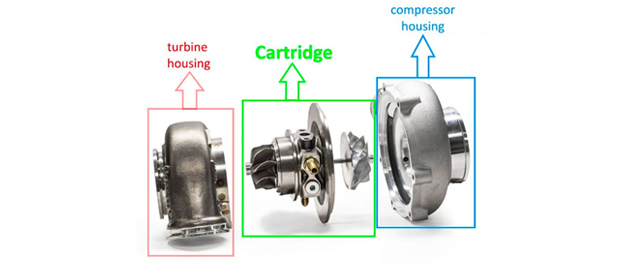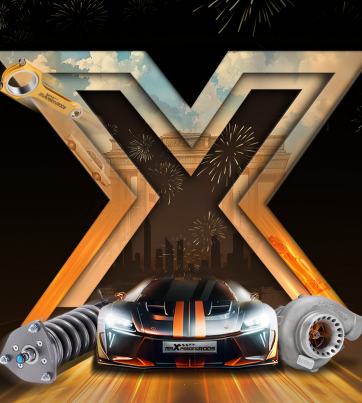WHAT IS A TURBO CARTRIDGE?
A CHRA, or Center Housing Rotating Assembly, also known as the turbo cartridge is the very core of the turbocharger. It is located in the very center of the turbo, with the compressor housing and the turbine housing being bolted onto it.

WHAT'S INSIDE A TURBO CARTRIDGE?
A turbo cartridge houses all the key turbo components. In addition to housing the turbine wheel and the
compressor wheel the cartridge also houses the turbo shaft, bearings as well as oil and coolant
passageways, in case of water-cooled turbo. Basically, all the most important turbo components are
located either inside or on the turbo cartridge.
If your turbo has failed or simply come to the en of
its life after many miles of use the fastest and most cost effective way to repair a turbocharger is to
replace the turbo cartridge or CHRA. In reality, turbine housings and compressor housings are simple
castings without any moving parts, and this why these parts are almost infinitely reusable. Replacing
the CHRA alone restores perfect functionality to the turbo but reduces the cost, because you reuse your
old housings. Additionally, turbo cartridges offer a simple and effective way to upgrade your turbo and
improve its performance or the strength of its internals if you are interested in increasing boost and
horsepower levels. The turbine and compressor housings are the largest and heaviest part of turbocharger
so reusing your old ones and only buying the CHRA greatly reduces shipping costs too.

HOW A TURBO CARTRIDGE WORKS?
Exhaust gasses entering the turbine housing spin the turbine wheel which then spins the compressor wheel, because these two parts are joined together via a common shaft. The entirety of this shaft sits within the turbo cartridge and is lubricated by oil to reduce friction and cool the turbo. When a turbo is both oil cooled and water cooled, the turbo cartridge, in addition to oil channels, also has coolant channels in it. And although coolant never comes in direct contact with the shaft, like the oil does, a water-cooled turbo is is better able to keep oil temperatures in check, because it helps prevent oil temperature spikes that can occur when the turbo is exposed to high loads and stresses.
Because the turbo shaft together with the
turbine and compressor wheels sees extremely high rpm (often above 200.000) the balance of a turbo
cartridge
is vital for the turbo's longevity. A CHRA that isn't fully and properly balanced will result in
accelerated
wear to the bearings and will quickly cause a turbo failure.
Speaking of bearings, a turbo
cartridge can
have two different kinds of bearings inside:
Journal bearings:Journal bearings control the radial movement of the shaft and are the most common type of bearing on a turbo cartridge. They are proven design that is capable of providing the turbo with a very long lifespan and will suit a very wide variety of application. However, journal bearings aren't capable of providing good axial movement control for the shaft and this is why journal bearings must be paired with a thrust bearing to prevent excessive shaft thrust play.
Ball bearings:Ball bearing cartridges offer advantages for performance and racing applications because they reduce friction, this reduces parasitic losses and helps the turbo spool up faster. Although the difference between a ball bearing and journal bearing turbo can be difficult to feel on the street during normal driving, in racing every little bit matters and a ball bearing turbo can be a significant advantage on some types of motorsport.
WHY BUY TURBO CARTRIDGES FROM MAXPEEDINGRODS?
MaXpeedingRods has been engaged in the research, development and manufacture of high-quality
turbochargers and turbo cartridges for decades. We offer turbo cartridges at affordable prices, made
from high-quality materials and components to ensure desired performance and durability.
All our cartridges are carefully and accurately balanced to very tight tolerances to ensure long-lasting boost.
Our street performance cartridges feature high-quality journal bearings with high precision cast
aluminum compressor and turbine wheels to ensure optimized spool-up and reliable performance in the
200-600 horsepower range.
Our sport performance turbo cartridges take things a step further with CNC
machined aluminum compressor and turbine wheels to ensure greater durability and ability to cope with
extremely high boost pressures and RPMs. A stronger bearing structure with improved thrust bearings
ensures that our sport performance turbos can support boost pressures of up to 3.0 bar and horsepower
ranges of 300-850 hp.
WHAT ARE THE SYMPTOMS OF A BAD OR FAILING TURBO AND TURBO CARTRIDGE (CHRA)?
The CHRA is the very heart of the turbo and the vast majority of turbocharger failures occur within the cartridge because this is the part that houses the turbo shaft, which sees RPM in excess of 200.000, and therefore it is the cartridge that sees the greatest stress in a turbo. The cartridge is also exposed to turbo pressure related forces which greatly stress the bearings inside the CHRA and overtime create play between the shaft and the bearings resulting in excessive oil consumption and other problems. On the other hand compressor housings and turbine housings rarely experience failures, which is why cartridge is the actual source of most of the following turbo related problems
Burning oilWhen a turbo starts burning oil the culprit is always the cartridge. Worn seals and bearings cause oil to escape past them leading to excessive oil consumption and burning as the turbo pushes the oil into your intake manifold and combustion chambers. Replacing the entire cartridge is often faster and more cost effective than rebuilding it. Rebuilding a cartridge requires many parts, specialized tools and balancing, which is why buying a ready-made, factory-balanced cartridge can save you both time and money.
Weird noisesA cartridge with failed seals, bearings or damaged turbine and/or compressor wheels can produce all sorts of weird noises. A whining noise that resembles an ambulance siren is the most common, but noises can include hissing or even rattling in extreme cases.
Loss of performanceA failed cartridge will prevent the turbo from spooling up properly and from generating the kind of pressure needed for proper performance. You will be able to feel this as an increased delay in acceleration when you step on the gas pedal and/or as an overall reduction in acceleration and tops speed.
HOW TO INSTALL A TURBO CARTRIDGE?
Once you remove the turbocharger from your car, installing the turbo cartridge is extremely simple. You only need to unbolt the turbocharger compressor housing and the turbine housing from your old CHRA or cartridge. Once you have removed both housings, simply install them onto your new cartridge. Before removing the housings from your old cartridge make sure to mark the old cartridge and the housings so you can install them into the same position on the new housing to ensure your turbo has been properly clocked back into the same position. Ba careful to reinstall all seals into their proper position.







